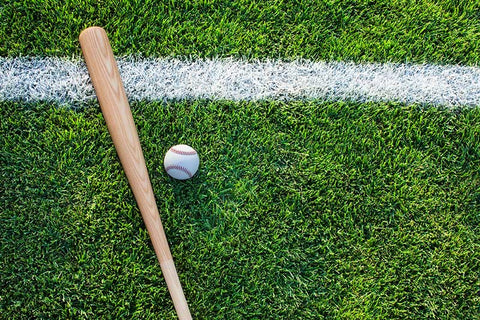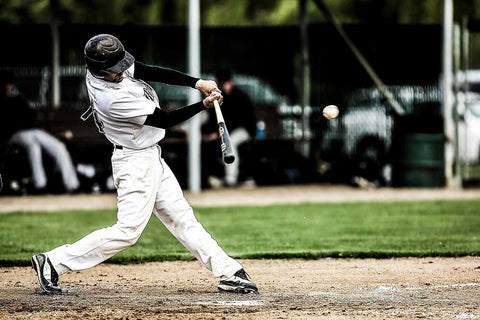The Great Debate - Wood VS Metal
 The great debate of which type of baseball bat is better has raged on for years, and will more than likely continue long into the future. Which is better? A Wood bat, or metal bat? However, for any batter that is trying to improve their swing, their batting average, their RBIs, or just their game in general - the debate is over. Wood is the clear choice.
The great debate of which type of baseball bat is better has raged on for years, and will more than likely continue long into the future. Which is better? A Wood bat, or metal bat? However, for any batter that is trying to improve their swing, their batting average, their RBIs, or just their game in general - the debate is over. Wood is the clear choice.
In this blog we'll look at three key metrics to ending the debate.
1. Performance
2. Affordability
3. Safety
Wood bats sweep the competition in all three metrics, but let's take a deeper look at why.
Performance
Better Form & Improved Strength
Metal Bats tend to be unbalanced. They are light, and end loaded - putting most of the weight in the barrel, or having a longer barrel. Using an end metal bat leads to a more golf club like swing. This causes your swing path to typically go from low to high, causing a high arc and increasing the probability of pop-flys.
Wood baseball bats are more properly weighted, due to the manufacturing process and the limitations of the media. You can always make a lighter metal - wood has limitations. This means you end up with a more evenly distributed weight across the length of the bat. The result: better balance to drive the ball. This in turn results in a more level swing , causing a a flatter trajectory with gradual rise for extra distance, which translates to more line drives, and beyond.
Understanding Your Sweet Spot
 The sweet spot, as it is commonly referred to is the the chunky part of the barrel, usually located between two - six inches from the end of your bat. This is the optimal area in which to hit on a bat. Learning where the sweet spot is, is the key to making good contact, and thus getting the most out of each at bat. It's true that metal bats also have a sweet spot, but they don't offer the same amount of feedback to the player, so you can never learn as much.
The sweet spot, as it is commonly referred to is the the chunky part of the barrel, usually located between two - six inches from the end of your bat. This is the optimal area in which to hit on a bat. Learning where the sweet spot is, is the key to making good contact, and thus getting the most out of each at bat. It's true that metal bats also have a sweet spot, but they don't offer the same amount of feedback to the player, so you can never learn as much.
Increased Pitch Discipline & Strike Zone Awareness
Not every pitch is hittable. With metal bats you may get away with swinging at more bad pitches, and making more mishits. A wood bat isn't as forgiving, and swinging at bad pitches, and mishitting can lead to stinging hands, and broken bats. By understanding a wood bats barrel, and the sweet spot - you'll learn to be more selective of the pitches you swing at, and develop a better awareness of your strike zone. You'll also learn how to make adjustments to your swing, like dragging your hands in close to your body to get the sweet spot around on an inside pitch, or extending to get good contact on an outside pitch.
All of this translates to better mechanics, and more successful at bats.
Advantages of Metal Bats
It is true metal bats can offer more forgiveness, and a bigger sweet spot.
More Forgiving
A metal bat can withstand more mishits than wood bat. A pitch that would break your wood bat might turn into a single with a metal bat.
Bigger Sweet Spot
Plain and simple, a metal bat has a larger sweet spot. Due to the fact that metal bats are hollow, they can have a larger barrel, and thus a bigger sweet spot, and a bigger bat in general. This also means they can be as light as legally possible - regardless of hitter type, contact, extra bases or power hitters.
Believe me - we work with wood bat manufacturers daily, and they get it. Players want as big a barrel as possible. They want the bat as light as possible, with a barrel as long as possible... There's no argument that metal bats (and composite bats) give you a bigger bat. They give you a lighter bat, and more singles off the handle. A single piece wood bat, being completely solid, properly weighted has a smaller sweet spot. You can also only achieve a certain barrel diameter and length on a wood bat before the bat becomes too heavy. But as discussed above - These limitations actually make you a better, more fundamentally sound player!
A player who learned how to bat using a wood baseball bat has better distance, and trajectory. Regardless of whether you're talking about Little League, the Minors, the Majors, or softball. The ability to make better contact means more hits. More balls that find the gap. Higher Batting Averages, and more RBIs.
Affordability
The average price for an in demand composite or metal bat runs three to four times higher than the price of a high quality wood bat. A player looking to replace his bat every year can expect to spend upwards of $300.00-400.00. This could be because of changes in popularity, compliance, or dead spots developing in the bat. This makes wood bats much more cost effective.
When you add in the additional power you get from a wood bat over a metal bat - the benefits extend beyond just the price tag. Learning to lay off bad pitches, and make solid contact will help you make your wood bat last for a very long time. You would have to break three to four bats per season, just to be equal to the price of a metal bat. And if your doing that - then your probably using a low-quality, sawn billet made bat. You can read more about the difference between sawn and split billets, and what makes a good wood baseball bat here (coming soon).
Safety
 Player safety has been pushed to the forefront of our awareness in recent years. From the NFL and their helmet rules, to many leagues switching to wood only bats. Ask anyone who's played the infield, and they have a story about a line drive that almost knocked them out. In youth baseball, there have even been fatalities.
Player safety has been pushed to the forefront of our awareness in recent years. From the NFL and their helmet rules, to many leagues switching to wood only bats. Ask anyone who's played the infield, and they have a story about a line drive that almost knocked them out. In youth baseball, there have even been fatalities.
Standards are being put into place fortunately, to protect players. Things like the USA Baseball bat standard, NCAA standard, BBCOR, and BST (Softball) are being put into place. These standards are being implemented to establish wood-like performance, and will help maintain the integrity of the game. The idea here, is to lower the exit velocity of a ball coming off the bat. This gives fielders more time to react, and results in a safer game for everyone.
Safety Issues with Metal Bat Modifications
So... Because there are safety standards in place - this is a non-issue. Right? Well... not so fast. One of the remaining concerns with metal bats, is that they can be modified post purchase to enhance performance. Metals bat can be shaved - making the walls of the bat thinner. This creates a trampoline effect which transfers more energy, and therefore exit velocity to a ball leaving the bat. This is dangerous, and difficult to detect. It relies on umpires being in the know, and having a keen eye to detect illegal bats.
Furthermore - some of the well known governing bodies - don't even test the bats. Despite the fact that bats need their stamp of approval to be considered legal. I wonder where the certification fees (paid by bat manufacturers) go?
Wood Bat Safety
Wood bats too, have safety concerns. As discussed earlier, mishitting can cause a wood bat to break. Several years ago (2008), wood bats - maple in particular - got a bad rap for breaking. Barrel heads flying down the baseline, or into the stands certainly didn't help, and it was a real issue. Players, umpires and even fans were getting injured. As bats continued to be made with smaller handles, and bigger barrels, this issue was perpetuated. Starting in 2008 MLB (through its safety and Health Advisory Committee) conducted a Hurculean Effort to better understand what was causing wood bat breakage. Particularly, multi-piece failure or MPF. The study found that the main cause of broken bats, regardless of wood species, was what is known as slope-of-grain or SOG. SOG is the angle, relative to the grain direction of a log, that a piece of wood is cut. The study also found that wood density played a significant role in bat breakage. As a result of this study the team made nine recommendations, which were all adopted by MLB with approval of the Major League Baseball Players Association. As of 2009 all MLB bat manufacturers were required to meet these standards:
- All bats are required to conform to SOG wood-grading standards. This means all bat-making billets have to meet a 5 degree maximum deviation from perfectly straight grain along the 2/3 length of the bat from the handle through the taper of the bat. This translates to an SOG ratio of 1:20.
- Ink Dot. Bat manufacturers were required to place an ink dot 12 inches from the knob, on the tangential surface of the handle on all sugar maple, and yellow birch species bats, prior to applying a finish. When the ink soaks into the wood, it will bleed along the wood grain - making it easier for MLB inspectors, players, and manufacturers to determine SOG.
- The logo on maple and birch bats must be placed in a way that ball-bat contact occurs on the tangential (flat-grain) surface of the bat. (Ash logos are placed opposite of this due to the fact that ash will flake with repeated collisions on it's tangential surface).
- Handles on birch, and sugar maple bats must be natural, or clear coated only, making it easier to detect SOG issues. This standard was only implemented in the 2009 season.
- Bat manufacturers became required to be able to track a bat from production to MLB play, and back.
- Representatives of each authorized MLB bat manufacturer or supplier are required to participate in an MLB sponsored workshop, that covers wood science, engineering properties and wood grading practices.
- MLB, or its designated representatives can regularly visit bat manufacturers to audit manufacturing processes, and record-keeping with regards to bat traceability.
- Random audits at ballparks in MLB cities to ensure the new bat requirements are being followed.
- The establishment of a formal third-party certification and quality control program.
Additionally, as time passed MLB implemented more standards concerning drop weights, and bat dimensions.
The major finding that SOG was the culprit in bat breakage led Leatherstocking Timber Products - a premiere supplier of wood billets to baseball bat manufacturers around the country - to completely revolutionize the bat making industry with the invention of split billets. This one manufacturing change has had arguably the biggest impact on stopping bats from breaking. LTP deduced that using sawn billets causes billets to be weaker, because you are using a saw to force your way through the wood grain, whereas split billets are created by splitting the wood along it's natural weak points. Giving you a stronger billet to begin with. All bats sold at The Wood Bat Factory, regardless of manufacturer, were born of LTP billets. We have a whole article dedicated to split vs sawn billets here (coming soon).
With all of these changes, wood bat breakage in the Majors is down over 50% from where it was in 2008, proving that wood is not inherently dangerous.
Any quality wood bat manufacturer will maintain these standards at the amateur and youth level of their offerings. See the list below to make sure you are not using a bat that is too light, as these may have durability issues and are more prone to breakage, due to factors like handle thickness, pitch speed and other variables.
- (-3) or less for high school players
- (-5) or less for 13 year olds
- (-8) or less for ages 11 and under
In Closing

The Verdict Is In
Nothing beats a wood bat for distance and trajectory, once a player who knows how to hit the sweet spot. The only way to really learn that - is through using a wood bat. If properly weighted, a wood bat will make a player start to see pop-flys turn into line drives, and base hits...
Wood bats are far more cost effective than their metal counterparts. Even if you account for a broken bat (or two).
Wood bats are safer.
Swing Like a Pro. Use Wood.



Leave a comment